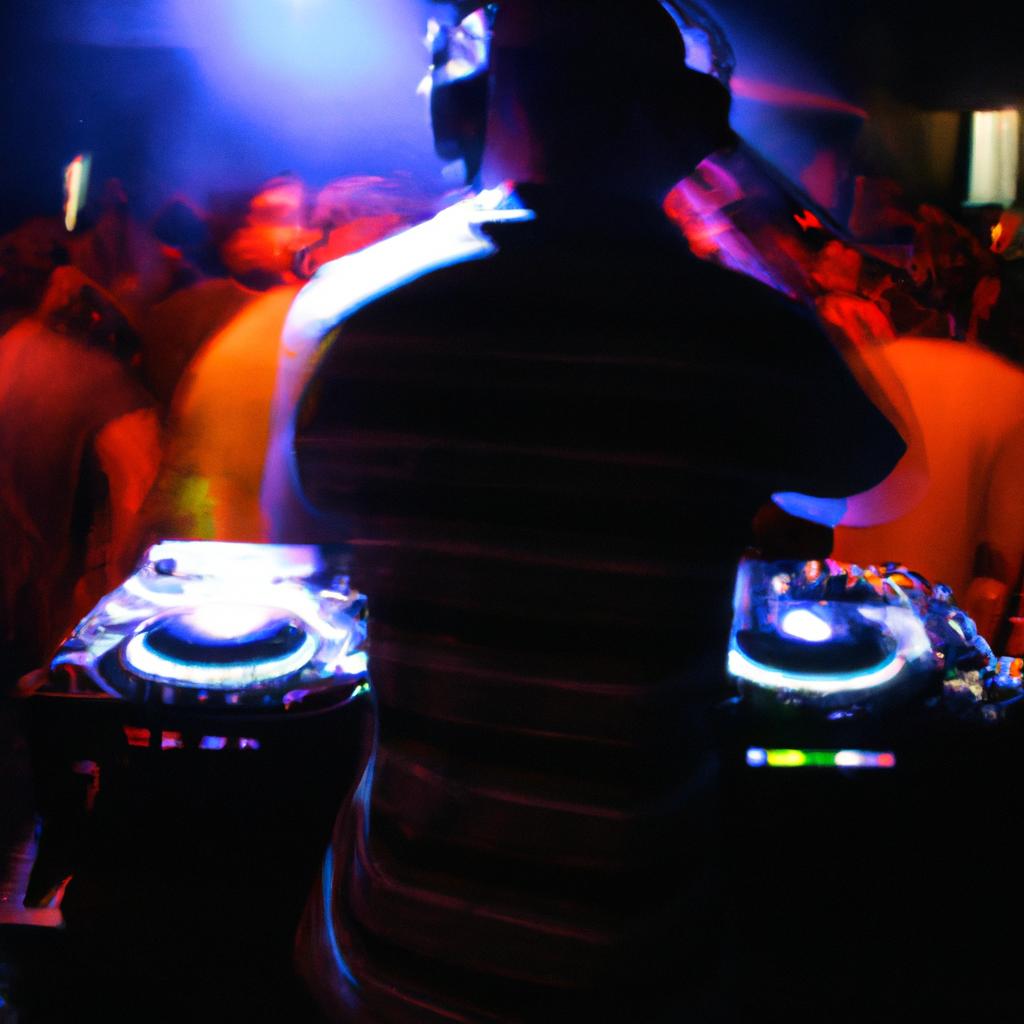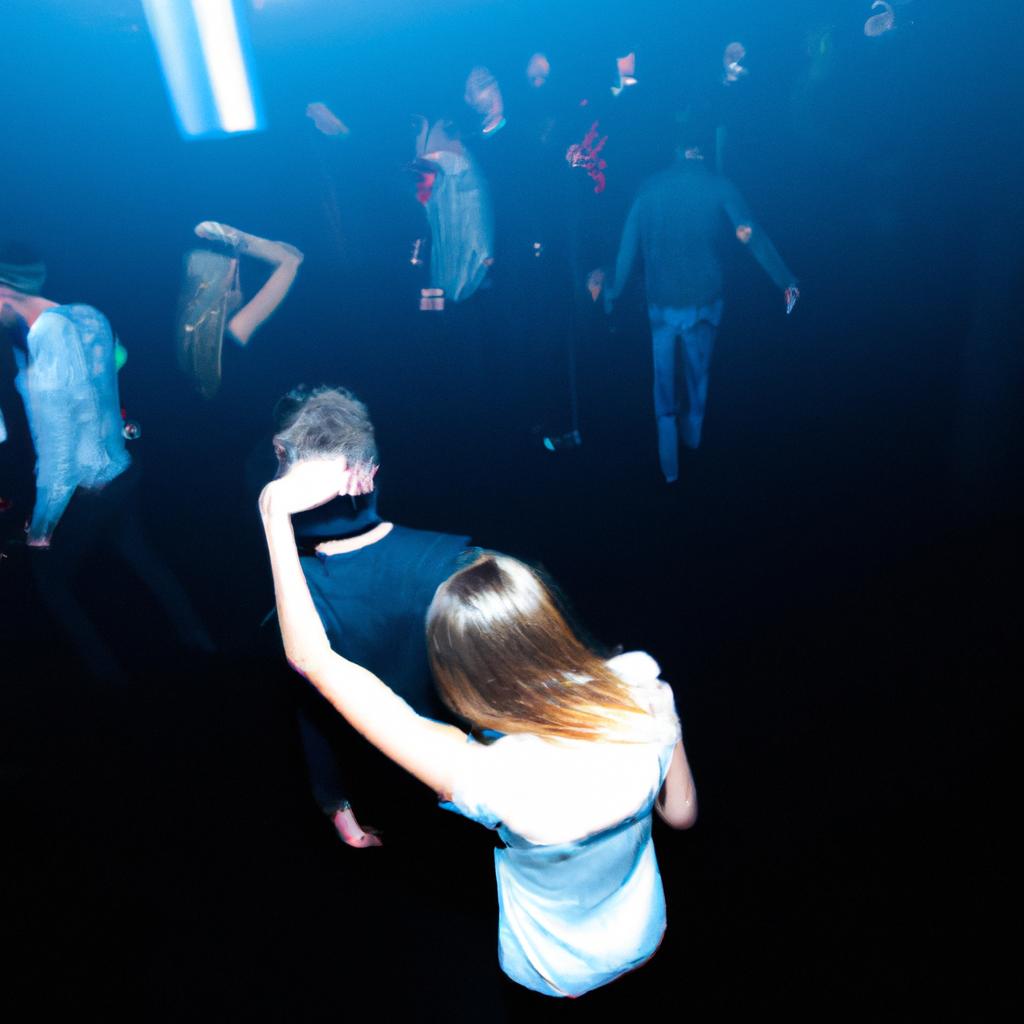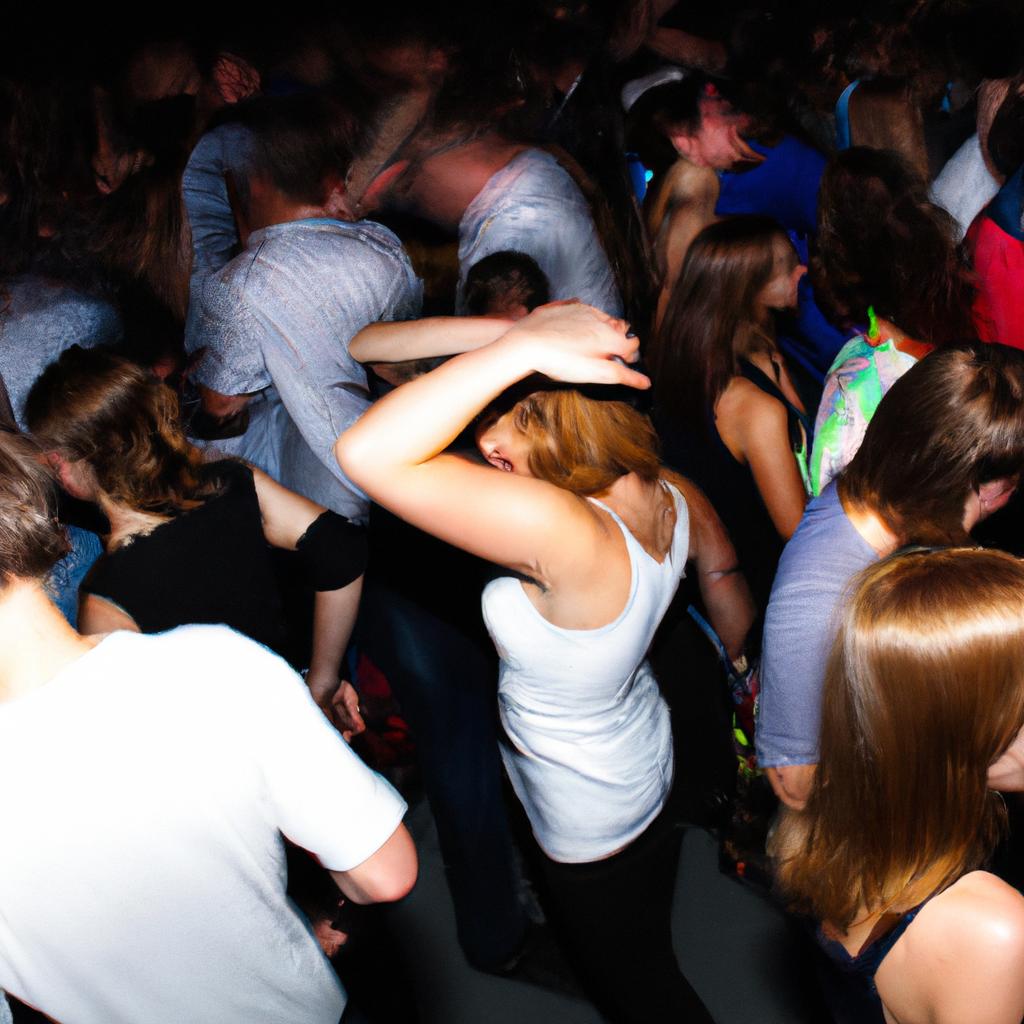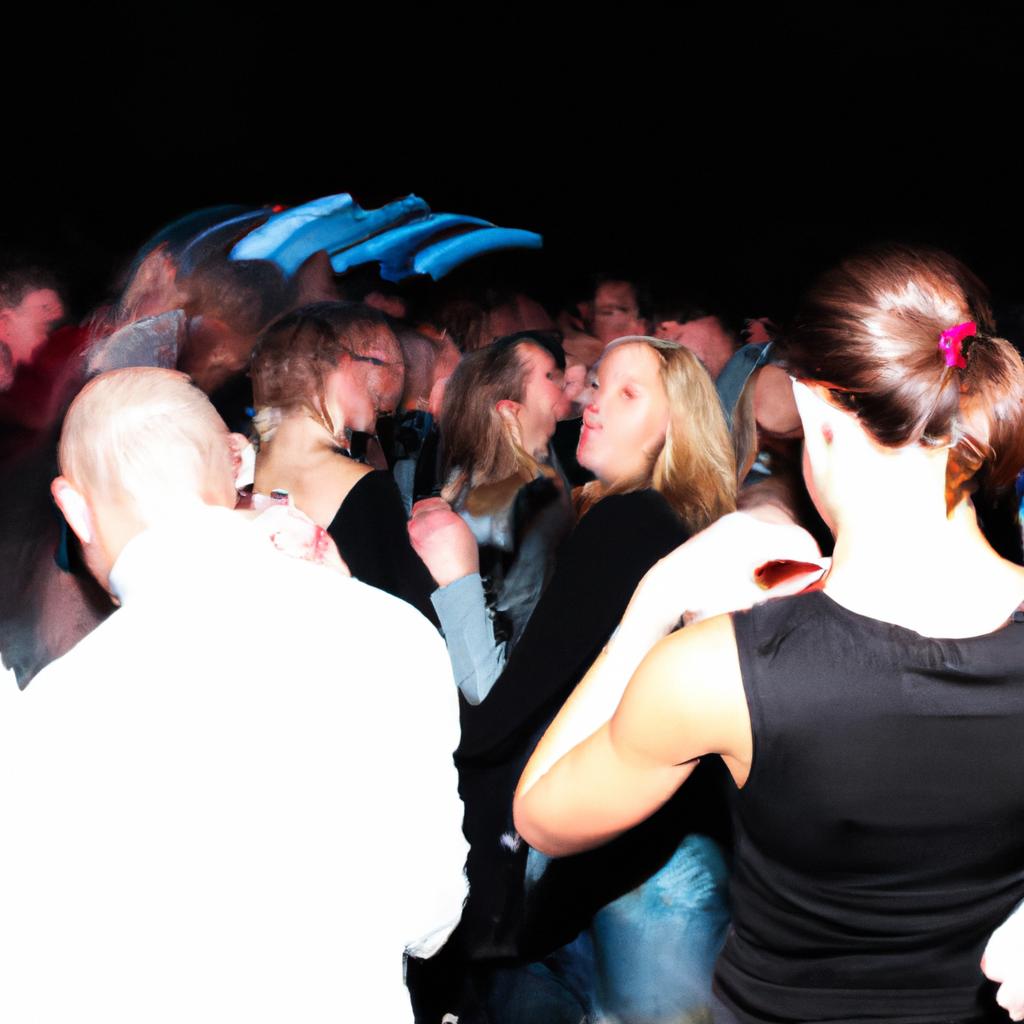Popular Dance Styles: The Dance Icons of Nightclubs
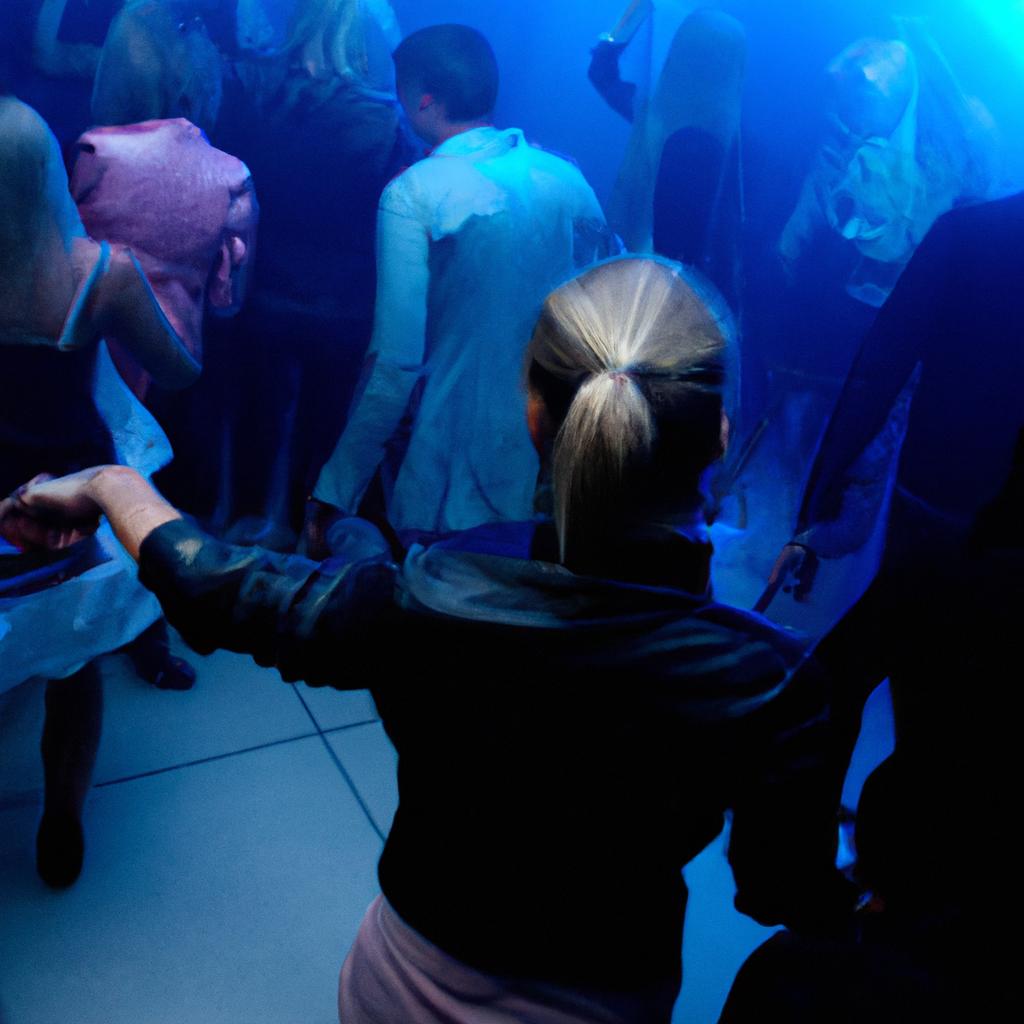
In the vibrant world of nightclubs, dance styles have evolved into iconic forms of expression that captivate and enthral audiences from all walks of life. From the smooth and sensual movements of salsa to the high-energy acrobatics of breakdancing, popular dance styles have become synonymous with the nightlife scene. This article explores the allure and significance of these dance styles as they take center stage in nightclubs around the globe.
One compelling example is the rise of hip-hop dancing as a prominent style within nightclub culture. Originating in African-American communities during the 1970s, hip-hop dance quickly gained popularity for its unique blend of athleticism, rhythm, and storytelling. Today, it has emerged as one of the most influential and widely recognized dance forms worldwide, showcasing diverse techniques such as popping, locking, and krumping. The intricate footwork, fluid body isolations, and explosive energy characteristic of hip-hop dancing create an electrifying atmosphere on club floors, attracting both participants and spectators alike.
Nightclub enthusiasts also find themselves drawn to Latin dances like salsa and bachata due to their infectious rhythms and sensual movements. Salsa originated in Cuba before spreading throughout Latin America and eventually reaching global recognition. With its lively beats and improvisational nature, salsa embodies passion and excitement, making it a perfect fit for the nightclub scene. The intricate footwork and partnering techniques create a dynamic and engaging experience for dancers, while the infectious music invites everyone to join in on the fun. Bachata, on the other hand, originated in the Dominican Republic and has gained immense popularity in recent years. Known for its smooth and sensual movements, bachata provides a more intimate and romantic atmosphere on the dance floor. Its seductive rhythms and close embrace allow dancers to connect with their partners on a deeper level, creating an enchanting experience that captivates club-goers.
In addition to hip-hop and Latin dances, breakdancing (also known as b-boying or breaking) has become an iconic dance style within nightclubs. Originating from African-American and Latino communities in New York City during the 1970s, breakdancing is characterized by its acrobatic moves, power moves, freezes, and intricate footwork. The combination of strength, agility, creativity, and musicality displayed by breakdancers creates a visually stunning spectacle that never fails to mesmerize audiences. Nightclubs provide a platform for breakdancers to showcase their skills in intense battles or freestyle sessions, adding an element of excitement and competition to the dance floor.
Overall, popular dance styles like hip-hop dancing, salsa, bachata, and breakdancing have become integral parts of nightclub culture worldwide. They bring people together through their unique blend of athleticism, rhythm, passion, storytelling, sensuality, and creativity. Whether you’re participating or simply enjoying the show as a spectator, these dance styles add vibrancy and energy to the nightclub scene that keeps people coming back for more. So next time you step onto a club’s dance floor or watch from the sidelines remember to appreciate the allure and significance of these iconic forms of expression that continue to captivate audiences everywhere
Salsa: The Sensual Latin Dance
Imagine stepping into a vibrant nightclub, the rhythmic beats of Latin music filling the air. Couples move across the dance floor with grace and passion, their bodies intertwined in an intricate dance known as salsa. Salsa is more than just a dance; it is a cultural phenomenon that has captivated people around the world.
One can hardly discuss salsa without acknowledging its origins. Emerging from the streets of New York City in the 1960s, this dynamic dance style draws influences from Cuban Son and Afro-Cuban dances like Mambo and Cha-Cha-Chá. It quickly gained popularity within Hispanic communities and eventually spread to other cultures, transcending borders and bringing people together through movement.
A key aspect that sets salsa apart is its sensuality. Partners establish a deep connection as they navigate complex footwork patterns, spins, and turns while maintaining eye contact throughout. This intimate interaction fosters trust and enhances the emotional intensity between dancers. To fully appreciate the allure of salsa, let us delve deeper into what makes this dance so captivating:
- Passion: Salsa ignites both physical and emotional energy within individuals, allowing them to express themselves freely on the dance floor.
- Connection: The constant connection between partners creates a unique bond rooted in trust and communication.
- Rhythm: Salsa demands precise timing and coordination with the music, requiring dancers to be fully immersed in its infectious beats.
- Versatility: From graceful movements to sharp turns, salsa offers endless possibilities for creativity and personal expression.
To further illustrate these characteristics, consider the following table showcasing some fundamental steps commonly found in salsa:
| Step Name | Description | Emotion Evoked |
|---|---|---|
| Basic | Simple step pattern forming foundation | Confidence |
| Cross Body | Dancer crosses over partner’s path | Connection |
| Cucaracha | Small quick steps executed in place | Playfulness |
| Dile Que No | Partner exchange involving a cross-body lead | Assertiveness |
In summary, salsa is an exhilarating dance style deeply rooted in Latin American culture. Its sensual and passionate nature, combined with its rhythmic intricacies, creates a mesmerizing experience for both dancers and spectators alike. As we transition to the next section on “Hip-Hop: The Urban Groove,” let us explore how this urban dance form has revolutionized popular culture while maintaining its essence of self-expression and individuality.
Hip-Hop: The Urban Groove
Building on the vibrant energy of Latin dances like Salsa, we now turn our attention to a dance style that has taken the world by storm – Hip-Hop. With its roots in African American and Latino communities, Hip-Hop has become a global phenomenon, captivating dancers and audiences alike with its dynamic movements and infectious beats.
Paragraph 1:
Imagine a group of street dancers gathered in an urban park, showcasing their skills amidst the bustling cityscape. This scene encapsulates the essence of Hip-Hop, where self-expression takes center stage through intricate footwork, body isolations, and fluid transitions. Originating in New York City during the 1970s, this urban form of dance draws inspiration from various styles such as breaking, popping, locking, and krumping. Each movement tells a story; it is a powerful medium for individuals to express their emotions and experiences.
Paragraph 2 (Bullet Point List):
When exploring Hip-Hop as a dance style, several key elements come into play:
- Rhythm: A crucial aspect of any Hip-Hop routine is staying in sync with the beat. Dancers showcase their ability to interpret different rhythms while maintaining impeccable timing.
- Creativity: In Hip-Hop, creativity knows no bounds. Dancers often incorporate freestyle improvisation into their performances, adding unique flair to each step.
- Individuality: One’s personal style shines through in the world of Hip-Hop. Dancers embrace their uniqueness and use it as a means of self-expression.
- Community: Beyond individual skill sets lies a strong sense of community within the Hip-Hop culture. Collaboration and unity are highly valued aspects that foster growth among dancers.
Paragraph 3 (Table):
To better understand the various subgenres within Hip-Hop dance culture:
| Subgenre | Characteristics | Notable Artists |
|---|---|---|
| Breaking | Acrobatic moves, floorwork, and power moves | B-Boy Lilou, B-Girl Terra |
| Popping | Isolations and robotic movements | Popin’ Pete, Salah |
| Locking | Fluid arm and hand gestures | Don Campbell, Shabba-Doo |
| Krumping | Aggressive and energetic movements | Tight Eyez, Miss Prissy |
Transition into the subsequent section:
As we immerse ourselves in the diverse world of dance styles, we now venture into the realm of classical elegance with Ballet: The Graceful Art Form. From urban grooves to refined poise, each dance style brings its unique charm to the ever-evolving tapestry of movement expression.
Ballet: The Graceful Art Form
Continuing our exploration of popular dance styles that have become icons in nightclubs, we now turn our attention to the elegant and captivating world of ballet. This art form has a rich history rooted in classical techniques and storytelling through movement. Let us delve into the beauty and grace that make ballet one of the most cherished dance forms worldwide.
Ballet dancers possess remarkable physical control and an ability to convey emotions through their precise movements. To illustrate this, let’s consider a hypothetical scenario where a dancer tells a heartfelt story solely through expressive gestures, conveying joy, sorrow, love, and triumph without uttering a single word. Such is the power of ballet – it captivates audiences by transcending language barriers and evoking deep emotional responses.
To better understand what makes ballet so mesmerizing, here are some key attributes that contribute to its enchantment:
- Technical Precision: Ballet demands meticulous attention to detail and rigorous training to achieve perfect balance, coordination, and alignment.
- Ethereal Elegance: Dancers execute fluid movements with apparent effortlessness, creating an illusion of weightlessness as they glide across the stage.
- Storytelling Through Movement: From fairy tales to tragic narratives, ballet communicates intricate narratives using body language alone.
- Collaboration between Music and Dance: Ballet choreographers meticulously select music compositions that enhance their visual storytelling.
In addition to these qualities, ballet also incorporates elaborate costumes, stunning sets, and innovative lighting designs – all aimed at enhancing the overall performance experience for both performers and spectators alike.
Through its timeless appeal and artistic expression, ballet continues to inspire generations around the globe. Its influence extends beyond traditional stages into contemporary interpretations seen in modern pop culture.
With its elegance explored from every pirouette to every grand jeté, we now transition into the passionate and intoxicating world of Tango – a dance that originated in Argentina.
Tango: The Passionate Argentine Dance
With its emphasis on elegance and precision, ballet has captivated audiences for centuries. However, dance styles in nightclubs often veer towards the passionate and sultry. One such style that perfectly embodies these qualities is the tango – an iconic Argentinean dance known for its fiery movements and intense connections between partners.
Tango, a captivating dance that originated in late 19th-century Buenos Aires, continues to enchant dancers around the world with its seductive allure. Picture this: dimly lit ballroom, couples entwined in an intimate embrace, their bodies moving as one to the intoxicating rhythm of traditional tango music. This visual alone evokes feelings of desire and sensuality, drawing both participants and spectators into its mesmerizing world.
To better understand the essence of tango, let’s explore some key features that make it so compelling:
- Close Embrace: Tango revolves around a close connection between partners characterized by chest-to-chest contact and interlocking legs. This physical closeness allows for intricate footwork while further intensifying the emotional bond during each step.
- Dramatic Expressions: Whether through subtle glances or dramatic sweeps across the floor, tango dancers use body language to communicate passion, longing, and even conflict. Each movement tells a story without uttering a single word.
- Complex Footwork: Tango showcases elaborate footwork patterns involving quick pivots, sharp kicks, and precise weight transfers. These intricate steps demand skillful coordination between partners and add an element of excitement to the dance.
- Improvisation within Structure: While adhering to certain fundamental elements like timing and basic figures, tango also encourages improvisation. Dancers can interpret the music differently every time they perform, adding spontaneity and personal expression to their routines.
In the realm of nightclub dancing, tango stands out as a captivating dance style that evokes emotions ranging from desire to longing. Its unique blend of passion, intimacy, and intricate footwork makes it an enduring favorite among dancers seeking to immerse themselves in its seductive embrace.
As we delve further into exploring the diverse world of popular dance styles found in nightclubs, our attention now turns towards Flamenco – the fiery Spanish dance that radiates raw intensity and emotional depth.
Flamenco: The Fiery Spanish Dance
Following the passionate and intense Tango, let us now delve into the world of Flamenco – a fiery Spanish dance that captivates audiences with its powerful movements and expressive music.
Flamenco, originating from Andalusia in southern Spain, is known for its vibrant energy and heartfelt performances. Imagine yourself sitting in a dimly lit flamenco club, surrounded by enthusiastic spectators eagerly awaiting the start of the show. The stage comes alive as the dancers make their entrance, clad in traditional flamenco attire adorned with colorful ruffles and fringes.
This dance style showcases not only physical agility but also emotional depth. The performers’ stomping feet create rhythms that resonate throughout the room while their skilled hands elegantly move through intricate gestures. Every movement tells a story; every note played on the guitar or sung by a vocalist adds to the narrative.
To better understand why Flamenco holds such sway over people’s hearts, consider these elements that contribute to its profound impact:
- Passionate Movements: The dancers’ fierce footwork, precise hand clapping, and dynamic body postures convey an overwhelming sense of passion and intensity.
- Emotional Expression: Through facial expressions filled with longing, pain, joy, or love, Flamenco dancers evoke deep emotions within both themselves and their audience.
- Cultural Heritage: Flamenco reflects centuries of cultural fusion between Arabic, Gypsy (Romani), Jewish, and Andalusian influences—making it a captivating embodiment of history and identity.
- Musical Fusion: With its unique blend of singing (cante), guitar playing (toque), rhythmic handclaps (palmas), and percussive footwork (zapateado), Flamenco creates an immersive musical experience that resonates deeply.
| Element | Description |
|---|---|
| Passionate Movements | Fierce footwork, precise hand clapping |
| Emotional Expression | Facial expressions conveying longing or joy |
| Cultural Heritage | Fusion of Arabic, Gypsy, Jewish, and Andalusian influences |
| Musical Fusion | Singing, guitar playing, rhythmic handclaps, percussive footwork |
As Flamenco performances draw to a close, the audience is left in awe of the dancers’ artistry and their ability to evoke such powerful emotions. The next section will explore yet another iconic dance style: Swing – an energetic jazz-infused partner dance that has enthralled generations with its infectious rhythm and lively movements.
Moving from the fiery passion of Flamenco, we now leap into the vibrant world of Swing – a high-energy jazz dance that never fails to get feet tapping and bodies moving.
Swing: The Energetic Jazz Dance
As we move from the passionate and intense world of flamenco, let’s now explore another popular dance style that has captivated audiences for decades – swing. With its energetic movements and vibrant music, swing dancing continues to be a favorite among dancers in nightclubs around the world.
Swing dancing originated in African-American communities during the 1920s-1930s and quickly gained popularity across various social classes. Its lively rhythm and improvisational nature make it an exhilarating experience both to watch and participate in. To illustrate its appeal, consider the case of Sarah, a young dancer who stumbled upon a swing dance event one evening while exploring her city’s nightlife scene. Intrigued by the infectious energy on the dance floor, she decided to give it a try. From that moment onwards, swing became her go-to dance style whenever she wanted to have fun and connect with others through movement.
Here are some key characteristics of swing dancing:
- High-energy movements synced with upbeat music.
- Improvisation and creativity encouraged within established frameworks.
- Partner-based interactions that emphasize connection and communication.
- A focus on rhythm and syncopation, allowing dancers to express themselves within the music.
| Key Characteristics of Swing Dancing |
|---|
| Energetic Movements |
| Improvisation |
| Partner-Based Interactions |
| Rhythm and Syncopation |
Through these elements, swing dancing creates a sense of joy, freedom, and vitality that resonates with dancers of all ages. It offers not only physical exercise but also an emotional release as individuals immerse themselves in the dynamic rhythms and expressive movements.
In conclusion (in place of “In conclusion” or “Finally”), swing dancing continues to thrive as one of the iconic dance styles in nightclubs. Its ability to bring people together, foster creativity, and provide a platform for self-expression has solidified its place in the hearts of dancers worldwide. Whether you’re an experienced dancer or someone looking to explore new forms of movement, swing dancing offers a vibrant and exhilarating experience that is sure to leave you wanting more. So put on your dancing shoes and get ready to swing!

